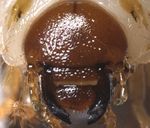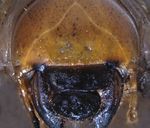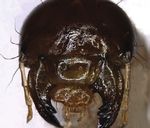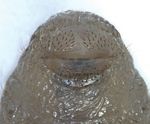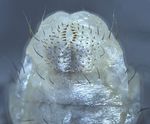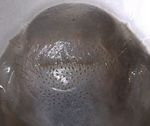African black beetle (Heteronychus arator) - Dairy Australia
←
→
Page content transcription
If your browser does not render page correctly, please read the page content below
Feed Planning
African black beetle
(Heteronychus arator)
African black beetle (ABB), an introduced scarab pest, is found
in Western Australia, South Australia, Victoria, New South Wales,
and Queensland. ABB has not been recorded in Tasmania.
ABB is a major agricultural pest, damaging several pasture species,
cereal crops, horticultural crops, and some forestry species.
ABB is emerging as a major pest in While there are limited chemical
pasture based agriculture, including options available for controlling ABB,
in the dairy industry due to the use several agronomic practices can be
of pasture and crop species that the implemented to renew damaged
beetle feeds on. Pasture grass species paddocks. As ABB is often mistaken for African black beetle larva. Image © Western
favoured by ABB include ryegrasses, other scarabs in pastures and cereals, Australian Agriculture Authority (Department of
paspalum, kikuyu and phalaris. best practice management begins with Primary Industries and Regional Development, WA)
Cereal crops (including wheat, barley, correct species identification.
triticale, maize and sorghum) are also
vulnerable to ABB attack. Identification and behaviour
In addition to crop and pasture ABB larvae have six legs, a brown
species, climate can influence head capsule, and a ‘C-shaped’ body.
ABB activity. ABB outbreaks are The larval body is grey in appearance
associated with warm springs. when young but transitions to creamy-
Larvae (the immature form) growth white when mature. They are ~5 mm
during spring is optimal at soil when they hatch, growing to ~25 mm
temperatures between 20–25°C, in length. The larvae damage pastures
while temperatures below 15°C are by pruning or completely severing
detrimental to development (King grass roots close to the crown of the
et al. 1981a). High soil moisture plant. In severe cases where infestation Blackheaded pasture cockchafer larva.
during early larval development is occurs, pastures become patchy and Image: Andrew Weeks, Cesar
also considered unfavourable (King can be rolled back like a carpet.
et al. 1981c). In New Zealand, ABB Main image: African black beetle adult.
Trevor James, AgResearch, NZ)
distribution is limited to areas with
a mean annual surface temperature
above 12.8°C (Watson 1979).
For more information, go to feed.dairyaustralia.com.auThe adult beetle form of ABB is 12–14
mm long, has a brown to black body
with indented longitudinal striations on
the wing covers, and flares and spurs
on its legs. Adult beetles have strong
nocturnal flight activity, and disperse
during their ‘roaming’ stage primarily
in autumn, leading to paddocks
becoming infested. The adults feed on
the stems of a variety of young plants
either underground or above the soil
surface, often killing growing points so
that the central shoots wither and the
plant dies.
ABB can be easily mistaken for other
scarab pests, including the redheaded
pasture cockchafer (Adoryphous African black beetle pasture damage. Image: Cesar
coulonii), the blackheaded pasture
cockchafer (Acrossidius tasmaniae),
and yellowheaded cockchafers
(Sericesthis spp.). These common
cockchafer pests share features
with ABB that are only discernible
to a trained eye or when comparing
species side-by-side. Nevertheless,
ABB can be distinguished from these Life cycle of African black beetle (Image: Karpyn Esqueda et al. 2017)
cockchafers by considering behaviour
and biology in addition to physical
attributes. Blackheaded pasture cockchafer Hosts
Blackheaded pasture cockchafers ABB larvae have a strong preference
The following parameters should be
also have a one year life cycle, but for forage pasture species such as
considered and used in a process
unlike ABB, adults lay their eggs ryegrass, tall fescue, kikuyu, and
of elimination:
between January and February. paspalum. Legume species are
Species life stage Blackheaded pasture cockchafer considered unfavourable, although they
A key difference between ABB larvae emerge in 3–4 weeks and may feed on white clover in absence
and other common scarabs is that reach the most damaging third instar of their preferred host species (King
ABB attack plants as both larvae larval stage in late autumn and winter. et al. 1981b). In contrast, the larvae
and as adults. Only the larvae of The larvae pupate in spring and adults of redheaded pasture cockchafer
blackheaded pasture cockchafer, emerge in mid-late summer. are common in pastures with a high
redheaded pasture cockchafer, subterranean clover content. The larvae
Redheaded pasture cockchafer
and yellowheaded cockchafers are of blackheaded pasture cockchafer will
Redheaded pasture cockchafer has also feed on legumes.
regarded as pests. Therefore, if adult a two-year life cycle. In year one,
beetles are found with accompanying redheaded cockchafer adults emerge Larval feeding behaviour
stem damage below or just above the from pupae from late summer to Larvae of ABB and other scarabs
soil surface, ABB is a likely a suspect. mid-autumn, but they do not surface are generally subterranean feeders,
Pest biology from the soil until August to October consuming and pruning plant roots.
when they take flight and lay eggs. The blackheaded pasture cockchafer
Understanding the biology and life
The eggs hatch in late spring and the larvae, however, is the exception to
cycle of common scarabs can assist
larvae reach the most damaging third this rule. After rainfall and heavy dews,
with distinguishing ABB at different
instar stage by early autumn in the blackheaded pasture cockchafer larvae
times of the year:
second year. Most damage is caused move onto the surface to feed on
ABB from March to June until winter foliage, resulting in small mounds of dirt
ABB has a one year life cycle. Adults temperatures hinder larval activity. surrounding tunnels on the soil surface.
lay their eggs in the soil in spring, Further feeding damage can occur
from late August to December until Anal opening
and larvae emerge in 2–5 weeks
depending on temperature, and reach pupation occurs. Scarab larvae have an anal opening
the most damaging third instar larval at their rear end which is visible
Yellowheaded cockchafers
stage from mid-January to March.1 with a hand lens. This opening is a
There are multiple yellowheaded horizontal split in ABB and redheaded
Larvae then pupate in the soil and
cockchafer species and while their life cockchafers. In the yellowheaded
emerge as adults, which go on to feed
cycles are largely unknown, they are cockchafer and blackheaded pasture
on pastures and crops throughout
thought to reach the most damaging cockchafer larvae, a Y-shaped anal
autumn, winter and spring.
third instar larval stage during winter. opening is evident.
1 These observations were made in New Zealand and may vary with local climateABB, redheaded pasture cockchafer and blackheaded pasture cockchafer anal openings, respectively. Images: Agriculture Victoria
ABB, redheaded pasture cockchafer and blackheaded pasture cockchafer head capsules, respectively. Images: Agriculture Victoria
Head capsule summer (Watson & Wrenn 1979). The only provide a low level of protection
The head capsule of ABB larvae is same method can be used in early against ABB and is unlikely to provide
mostly described as brown, whereas February, in which case larvae and adequate control in situations with
redheaded pasture cockchafers, adult numbers exceeding 15–20/m2 medium or high levels of ABB pressure.
yellowheaded cockchafers and is considered a damaging level (Dairy Other endophytes which provide good
blackheaded pasture cockchafers NZ, 2012). control of ABB include MaxP in tall
have head capsules that correspond fescue and U2 in festulolium.
With few effective ABB control
to their common names. Note that options available, the focus needs to ABB larvae
head capsule colour alone should not be on reducing the risk of damaging Commercially available endophyte
be used to distinguish ABB from other levels being reached by adopting the strains do not appear to provide
scarabs due to subjectivity in colour following combination of strategies control of ABB larvae (Bell et al., 2011).
perception from person to person, and when renewing paddocks damaged
variation in colour between individuals by ABB: Always seek professional advice when
of the same species. In addition to using endophyte infected pasture
differences in colour, redheaded Endophyte deterrents varieties to ensure the correct choice
pasture cockchafers have small pit Sow ryegrass varieties with is made for your farm and prevent the
marks on their head whereas ABB has endophytes that deter ABB. development of ryegrass staggers
a smooth head capsule. An endophyte is a fungus that in livestock.
lives harmoniously in a host
Monitoring and control Insecticides
plant, producing alkaloids which
There are monitoring guidelines that deter insects. Consider the use of insecticide
can be used to assess ABB pest treated seed when renewing pastures.
pressure.2 To estimate the risk of ABB adults Poncho® Plus seed treatment is
damaging larval populations over Egg laying by adults is reduced in the only chemical option registered
summer, take 10 random square- pastures dominated by grasses for ABB control in grass and
shaped soil samples per paddock infected with endophytes and broadleaf pastures. Control should
in September (Watson et al. 1980). hence larval damage may also be be expected for 3–4 weeks after
Each sample should be the width reduced. NEA2, AR37 and Endo5 sowing, although seed treatments
of a 20cm spade and ~10cm are commercially available ryegrass will not control heavy populations.
deep. Approximate pest pressure/ endophytes which provide resistance Chlorpyrifos is registered for ABB in
m2 can be determined by summing to damage from ABB adults. Standard maize in NSW. Off-label application
the number of ABB adults found in endophyte (SE) also provides good of organophosphates and synthetic
10 samples and multiplying it by 2.5. ABB control, however its use is not pyrethroids are not recommended for
If the average number of beetles is recommended as SE can cause severe control of ABB in pastures. Field trials
above 10/m2, the paddock could ryegrass staggers and other animal show that while foliar applications
be at risk from larval damage over health problems. AR1 endophyte will of alpha-cypermethrin (pyrethroid)
2 These observations were made in New Zealand and may vary with local climateand chlorpyrifos (organophosphate) References and Pavri and Young (2007) Pastures
may kill adult beetles, they do not useful resources (including lucerne) – winter rainfall.
necessarily reduce ensuing larval Bell et al. (2011) Black beetle: In ‘Pest of field crops and pastures:
populations (Eden et al. 2011). lessons from the past and options identification and control’ (Ed. P. Bailey),
for the future. Pasture Persistence CSIRO Publishing, pp. 393–411.
Crop rotation
– Grassland Research and Practice Watson (1979) Dispersal and
Rotate ABB-affected paddocks with distribution of Heteronychus arator
Series 15, 119–124.
an unfavourable crop or pasture. in New Zealand (Coleoptera:
Planting a legume, chicory or Dairy NZ (2012) Black beetle.
Farmfact 1–29. Scarabaeidae) Proceedings of the
brassica species in spring is likely 2nd Australasian Conference on
to disrupt ABB at the larval stage of Eden et al. (2011) Evaluation of spring
Grassland Invertebrate Ecology,
development (Bell et al. 2011). Adult and autumn applied insecticides
149–152.
ABB is migratory and can reinvade for the control of black beetle. New
crops and pastures sown in autumn Zealand Plant Protection 64, 63–67. Watson et al. (1980) Farm surveying
after a break crop, however the risk of black beetle populations in spring
Gerard et al. (2013) Influence of
can be managed using endophyte as an indicator of larval populations in
pasture renewal, soil factors and
varieties and seed treatments. summer. Proceedings of the thirty-
climate on black beetle abundance
Delaying sowing until May (if practical) third New Zealand Weed and Pest
in Waikato and Bay of Plenty.
will reduce the level of feeding Control Conference, 144–147.
Proceedings of the New Zealand
damage by ABB adults, which Grassland Association 75, 235–240. Watson and Wrenn (1979) An
decrease their feeding activity during association between Paspalum
Karpyn Esqueda et al. (2017) A review
the colder months. dilatatum and black beetle in pasture.
of perennial ryegrass endophytes and
Proceedings of the New Zealand
Remove feed source their potential use in management
Grassland Association 41, 96–104.
of African black beetle in perennial
Before establishing a new pasture,
grazing systems in Australia. Frontiers Acknowledgements
remove alternative food sources from
in Plant Science 8, 1–21.
in and around the paddock. This This article was compiled by Julia
includes winter grass (Poa annua), King et al. (1981a) Ecology of Severi and Dr. Paul Umina (Cesar).
paspalum, annual ryegrass, phalaris, black beetle, Heteronychus arator Thanks to Dr. Alison Popay and
and kikuyu. Varieties of perennial (Coleoptera: Scarabaeidae) - influence Dr. David Hume (AgResearch) and
ryegrass, tall fescue, and Italian of temperature on feeding, growth, Stuart Kemp (PastureWise) for their
ryegrass that do not contain the and survival of the larvae. New Zealand assistance in developing this article.
appropriate endophyte deterrents Journal of Zoology 8, 113–117. Thanks also to Dr. Kathryn Guthridge
should also be removed. The level King et al. (1981b) Ecology of and Cath Lescun for comments.
of control from sowing endophyte black beetle, Heteronychus arator
grass varieties and break crops will be (Coleoptera: Scarabaeidae) - relative
hampered if ABB has an alternative consumption of pasture plant roots
food source in the pasture or in by larvae. New Zealand Journal of
neighbouring areas. Zoology 8, 123–125.
Manage soil pH King et al. (1981c) Ecology of
black beetle, Heteronychus arator
Keeping soil pH high at around
(Coleoptera: Scarabaeidae) - relative
6 helps reduce numbers of black
consumption of pasture plant roots
beetle larvae (mechanism is currently
by larvae. New Zealand Journal of
unknown) but will not prevent
Agricultural Research 24, 87–97.
damaging populations from occurring.
Published by Dairy Australia Limited.
Whilst all reasonable efforts have been taken to ensure the accuracy
of the African black beetle fact sheet, use of the information contained
herein is at one’s own risk. To the fullest extent permitted by Australian
law, Dairy Australia disclaims all liability for any losses, costs, damages
and the like sustained or incurred as a result of the use of or reliance upon
1467.5 | Feb 2019
the information contained herein, including, without limitation, liability
Dairy Australia Limited ABN 60 105 227 987
stemming from reliance upon any part which may contain inadvertent
T + 61 3 9694 3777 F + 61 3 9694 3701
errors, whether typographical or otherwise, or omissions of any kind.
E enquiries@dairyaustralia.com.au
© Dairy Australia Limited 2019. All rights reserved. dairyaustralia.com.auYou can also read




